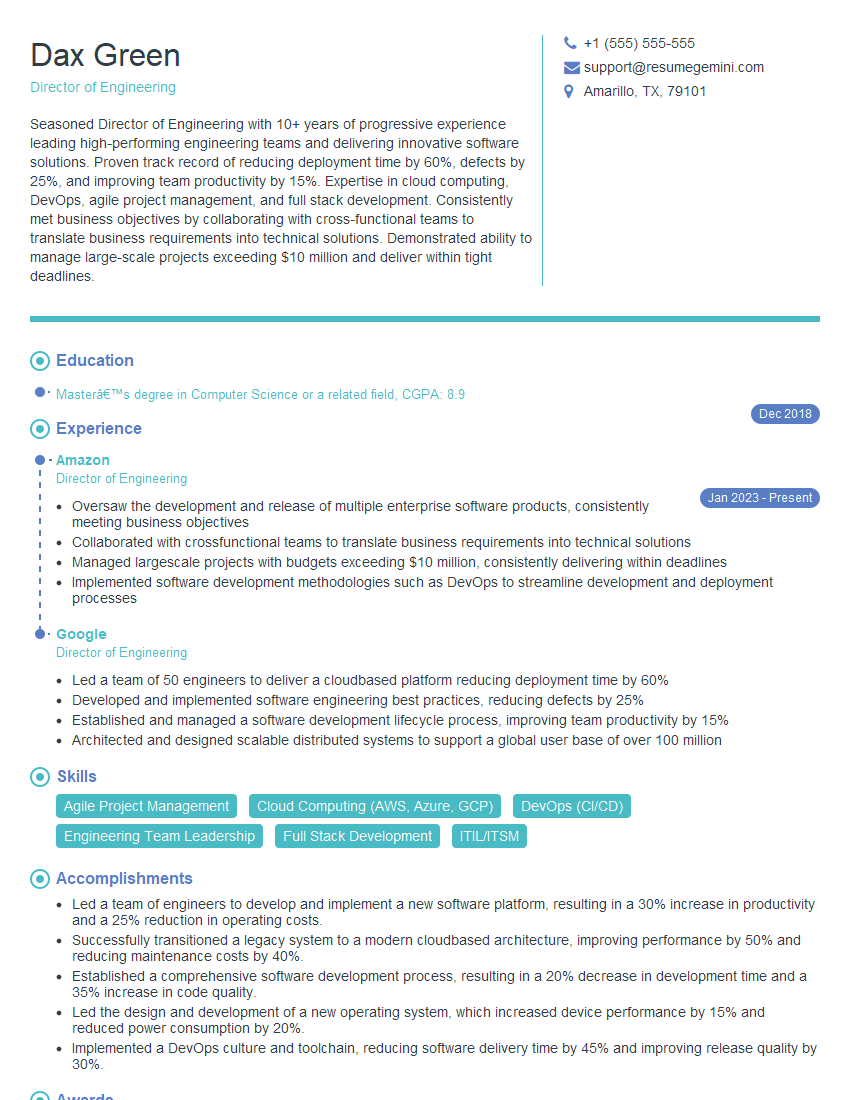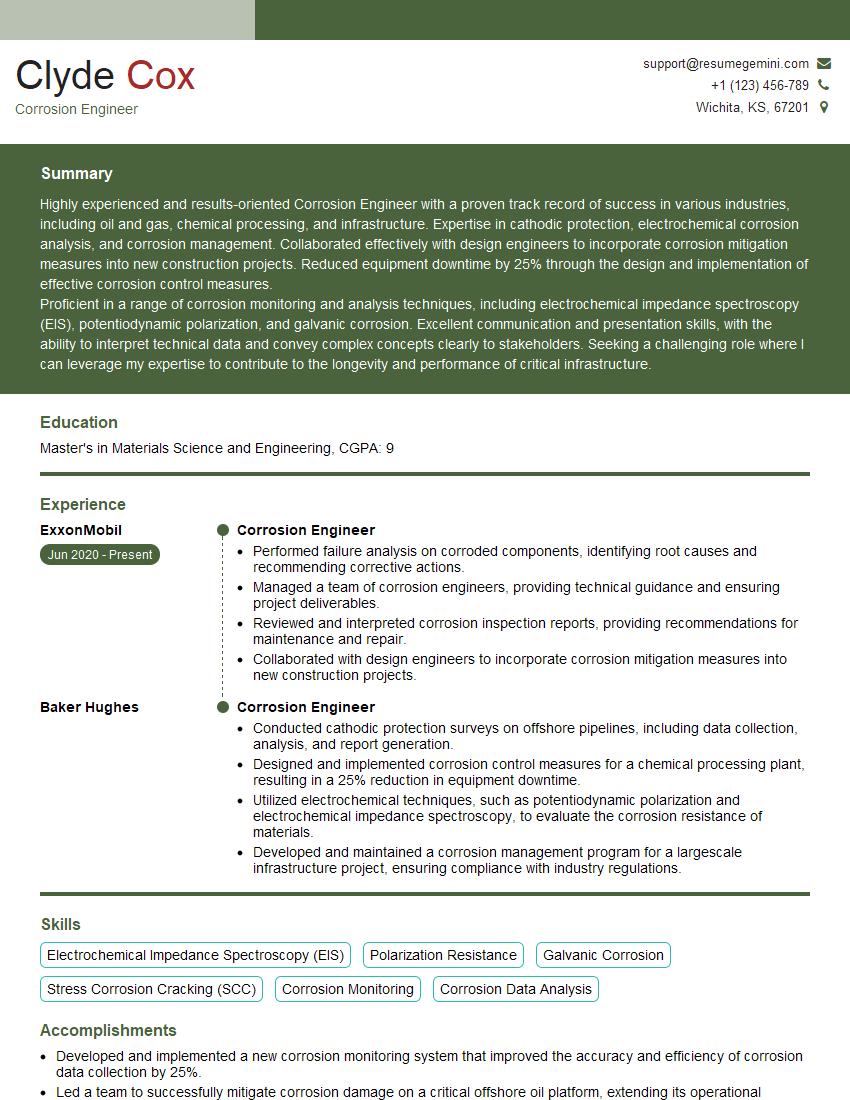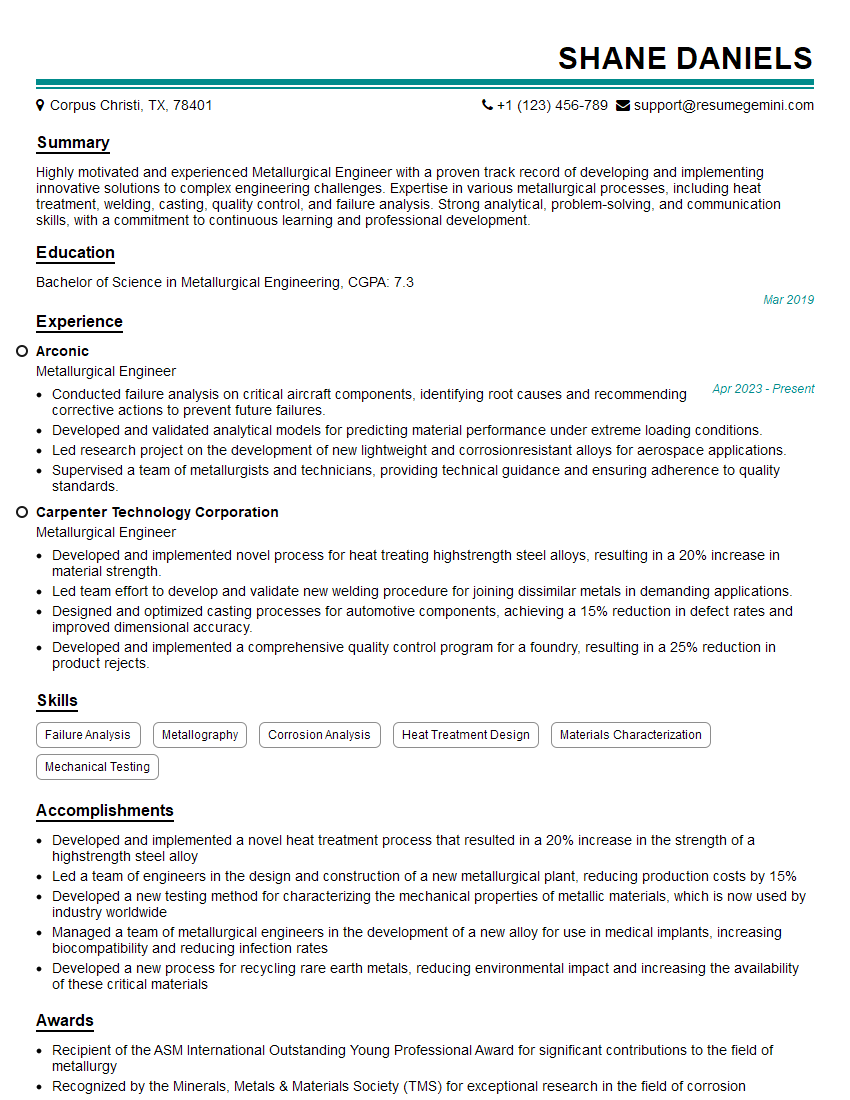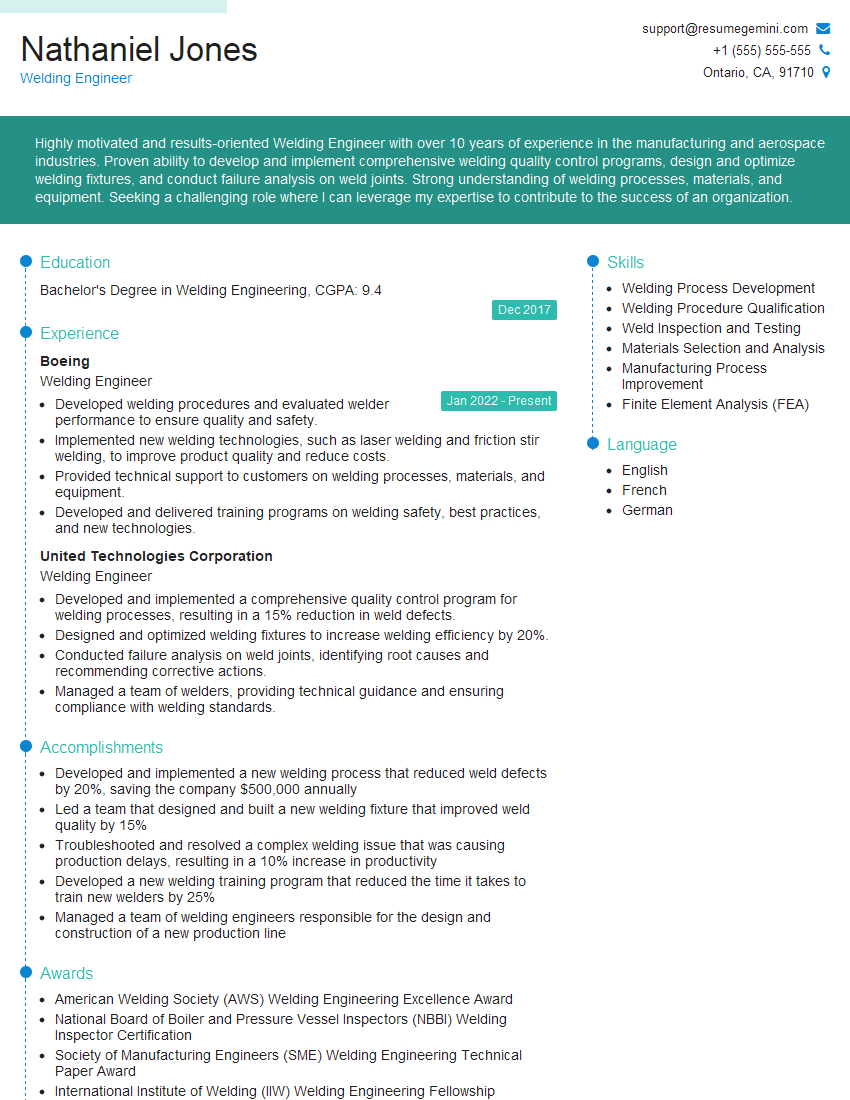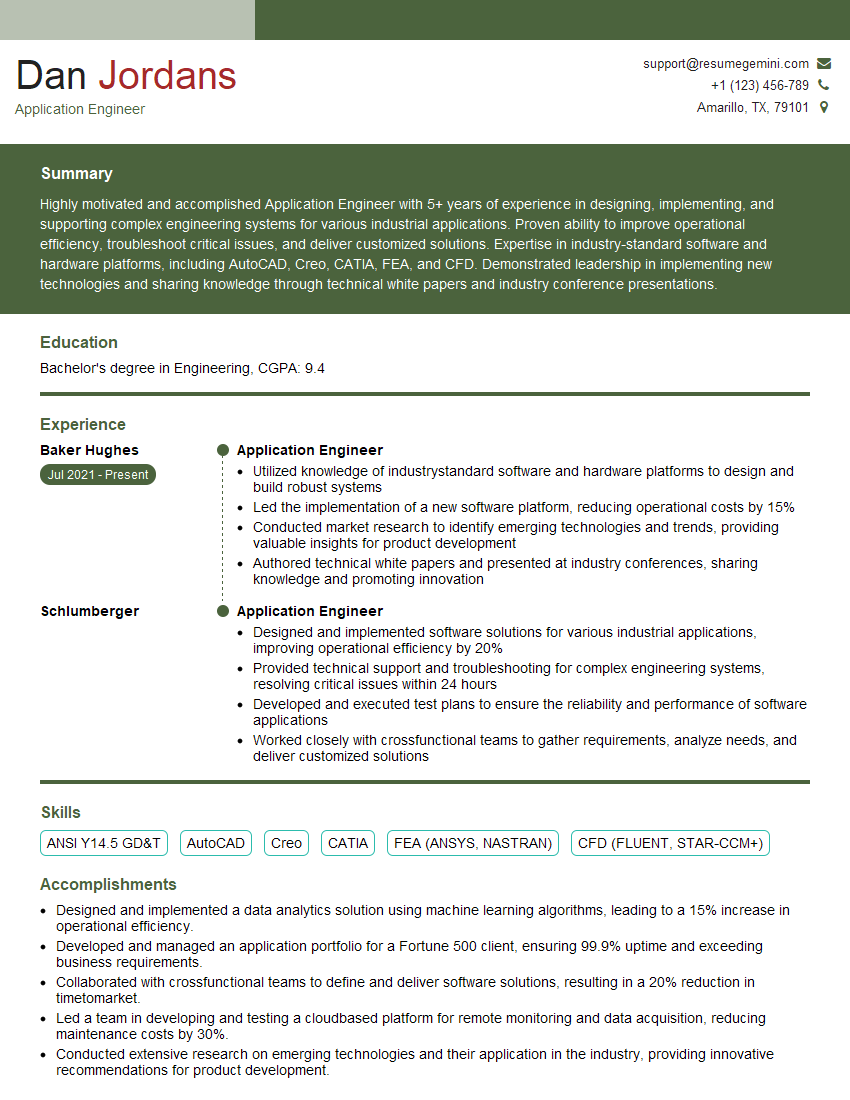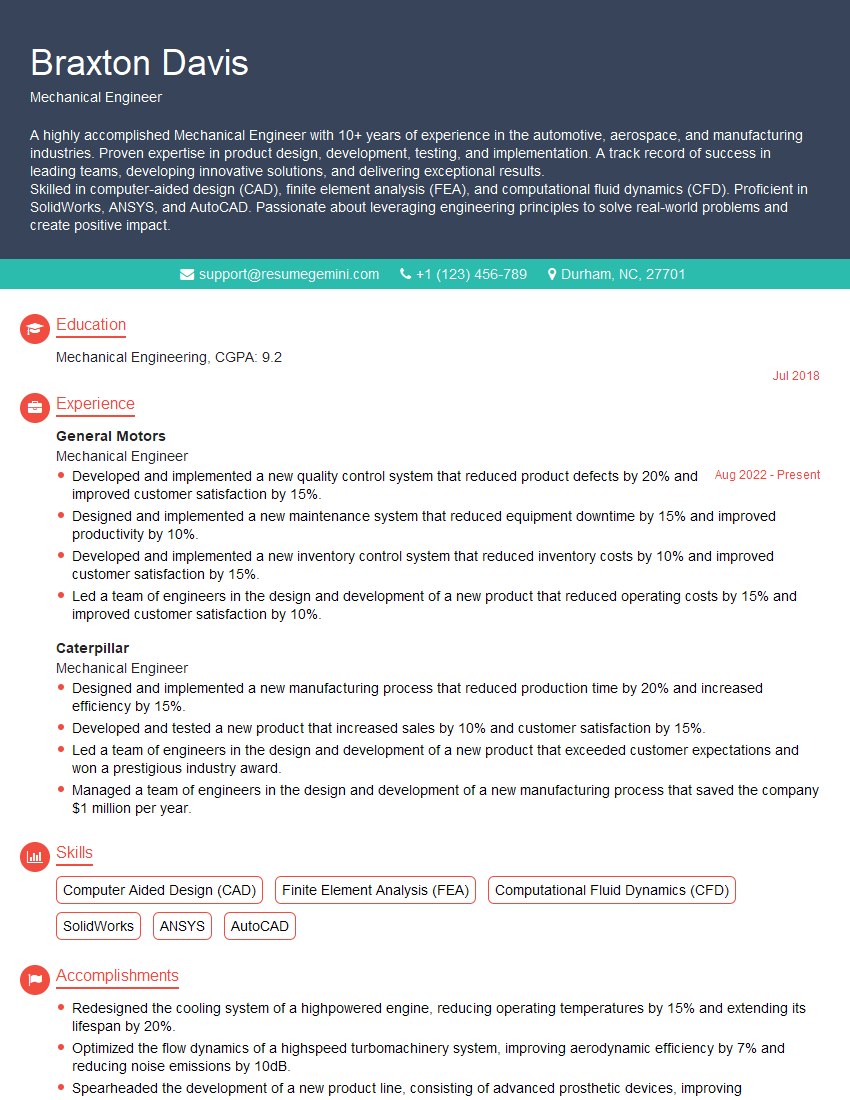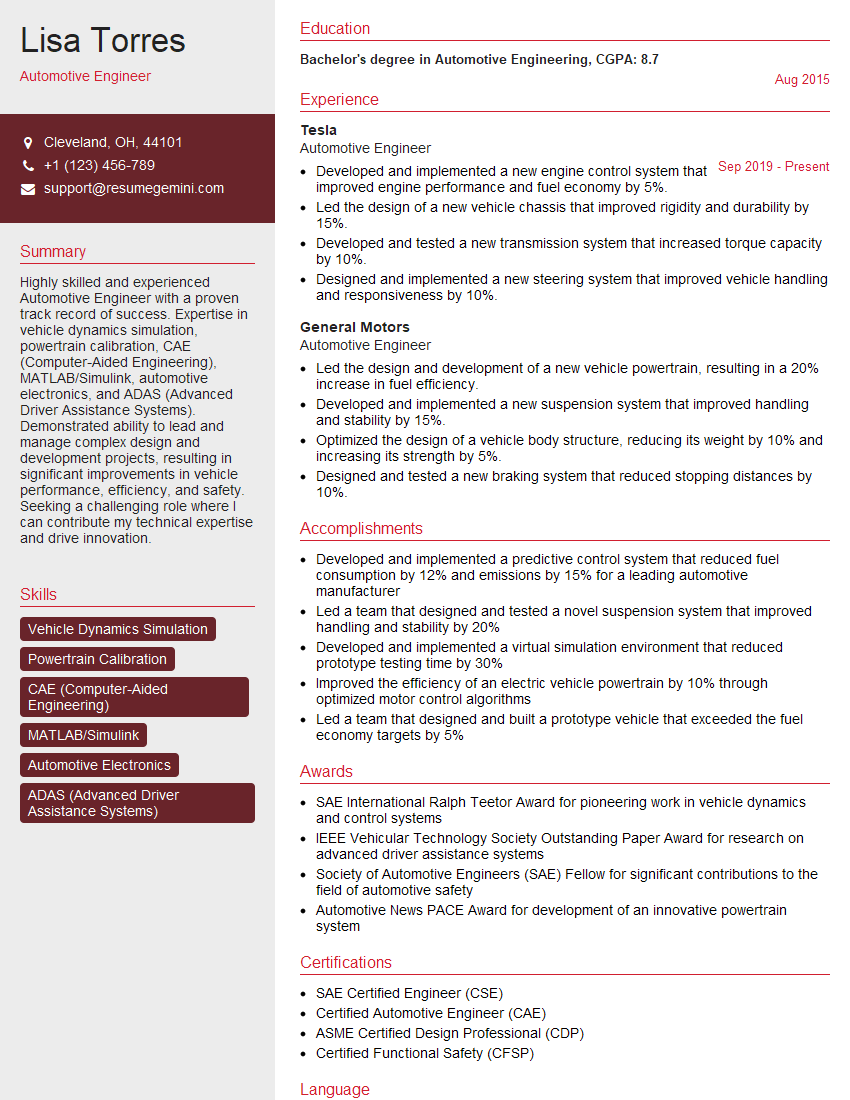Are you ready to stand out in your next interview? Understanding and preparing for Precipitation Hardening interview questions is a game-changer. In this blog, we’ve compiled key questions and expert advice to help you showcase your skills with confidence and precision. Let’s get started on your journey to acing the interview.
Questions Asked in Precipitation Hardening Interview
Q 1. Explain the mechanism of precipitation hardening.
Precipitation hardening, also known as age hardening, is a heat treatment technique used to significantly increase the yield strength of malleable materials, especially aluminum, copper, magnesium, nickel, titanium, and some stainless steels. The process relies on the principle of creating tiny precipitates within the material’s microstructure, which impede the movement of dislocations – the defects that cause material deformation. These precipitates act like obstacles, making it much harder for the material to deform under stress, thus leading to increased strength and hardness.
Imagine trying to push a shopping cart through a crowded market. The cart is the metal, and the shoppers are the precipitates. It’s much harder to push the cart when it has to navigate around all the people, compared to pushing it in an empty space. Similarly, the precipitates hinder the movement of dislocations, making the material stronger.
Q 2. Describe the stages of precipitation hardening.
Precipitation hardening typically involves three main stages:
- Solution Treatment: The alloy is heated to a high temperature where the solute atoms (like copper in an aluminum alloy) are completely dissolved into the solvent (aluminum). This creates a single-phase, solid solution. The material is then quickly cooled (quenched) to trap the solute atoms in the solution, preventing them from precipitating out.
- Aging (Precipitation): The quenched alloy is then heated to a lower temperature (aging temperature). At this temperature, the solute atoms become supersaturated and gradually precipitate out of the solid solution, forming very fine, dispersed precipitates. This process can be further divided into two sub-stages: incubation (early stages of clustering) and precipitation (formation of distinct precipitate phases).
- Overaging: If the aging process continues for too long or at too high a temperature, the precipitates grow larger and coarsen. This reduces the strength of the alloy because larger precipitates offer less impediment to dislocation movement. It’s like the shoppers in our analogy forming into large, less obstructive groups.
The optimal aging time and temperature depend heavily on the specific alloy composition.
Q 3. What are the key factors influencing the strength of a precipitation-hardened alloy?
Several key factors influence the strength of a precipitation-hardened alloy:
- Volume fraction of precipitates: A higher volume fraction of precipitates generally leads to higher strength, as long as the precipitates remain small and uniformly dispersed.
- Size and spacing of precipitates: Small, finely dispersed precipitates are more effective in hindering dislocation movement than large, coarse ones. The spacing between precipitates is also critical; optimally spaced precipitates create a denser network of obstacles.
- Type and crystal structure of precipitates: The nature of the precipitate and its crystal structure influences its interaction with dislocations. Some precipitate phases create stronger interactions than others.
- Matrix properties: The properties of the alloy matrix itself (e.g., its stacking fault energy) also affect the alloy’s overall strength.
- Alloy composition: The specific elements used in the alloy, and their concentration, significantly affect the precipitation process and the resulting strength.
Q 4. How does the aging temperature affect the properties of a precipitation-hardened alloy?
Aging temperature plays a crucial role in determining the properties of a precipitation-hardened alloy. An inappropriately chosen temperature can lead to either insufficient strengthening or overaging.
At low aging temperatures, the precipitation process is slow, resulting in lower strength and hardness. At high aging temperatures, the precipitation process is faster, but the precipitates may grow too large, leading to overaging and reduced strength. Therefore, an optimum aging temperature exists that maximizes the strength of the alloy, providing the finest and most evenly dispersed precipitates. This optimum temperature is carefully determined through experimentation for each specific alloy.
Q 5. What is the difference between solution treatment and aging?
Solution treatment and aging are two distinct but sequential steps in the precipitation hardening process. They have opposite effects on the alloy’s microstructure and properties:
- Solution treatment aims to create a homogeneous solid solution by dissolving all solute atoms within the solvent. It involves high-temperature heating followed by rapid quenching, leaving the solute atoms supersaturated in the matrix. This step creates the potential for later hardening.
- Aging involves heating the solution-treated alloy to a lower temperature, allowing the supersaturated solute atoms to gradually precipitate out, forming finely dispersed precipitates. This stage is where the actual hardening occurs.
Essentially, solution treatment sets the stage for aging by creating the supersaturated condition, while aging produces the precipitates responsible for increased strength.
Q 6. Explain the role of solute atoms in precipitation hardening.
Solute atoms are absolutely essential for precipitation hardening. They are the atoms that form the precipitates within the alloy matrix. Without solute atoms, there would be nothing to precipitate out, and the hardening mechanism would not function. The interaction between the solute atoms and the matrix during precipitation is what creates the fine, dispersed precipitates that impede dislocation motion and strengthen the material. Different solute atoms, in different concentrations, result in different types and sizes of precipitates, which significantly impact the final properties of the alloy.
Q 7. What are some common precipitation-hardened alloys?
Many common alloys utilize precipitation hardening to achieve high strength. Some notable examples include:
- Aluminum alloys: e.g., 2024, 6061, 7075. These are widely used in aerospace and automotive applications.
- Copper alloys: e.g., beryllium copper. Known for its high strength and electrical conductivity, used in springs and electrical contacts.
- Nickel-base superalloys: Used in high-temperature applications like gas turbines and jet engines. These often involve complex precipitation sequences.
- Titanium alloys: Used in aerospace applications requiring high strength-to-weight ratio.
The specific alloy composition is tailored to achieve desired mechanical properties for various applications.
Q 8. How is the precipitation hardening process controlled?
Precipitation hardening, also known as age hardening, is controlled primarily through precise manipulation of temperature and time. It’s a delicate dance of solubility and precipitation. The process involves three key stages: solution treatment, quenching, and aging. Solution treatment involves heating the alloy to a high temperature where the solute atoms (like aluminum in aluminum-copper alloys) are fully dissolved in the solvent matrix (like copper). This creates a homogeneous, single-phase solid solution. The temperature and time of this heat treatment are crucial and depend on the specific alloy’s phase diagram. Quenching rapidly cools the alloy, trapping the solute atoms in supersaturated solution. This supersaturated solution is metastable, meaning it’s not thermodynamically stable but kinetically hindered from transforming. Finally, the aging process involves reheating the quenched alloy to a lower temperature, allowing the solute atoms to precipitate out of the solution as finely dispersed particles. The temperature and time of aging determine the size, distribution, and volume fraction of these precipitates, directly influencing the final mechanical properties. Careful control over all three stages is paramount for achieving the desired strength and hardness.
Q 9. Describe the microstructure of a precipitation-hardened alloy after each stage of the process.
Let’s visualize the microstructure evolution:
- Solution Treatment: A single-phase, homogeneous solid solution. Imagine a perfectly mixed drink – no visible separation of ingredients. This is a soft, ductile state.
- Quenching: The microstructure remains essentially the same as after solution treatment, but now the solute atoms are trapped in a supersaturated state, like a shaken bottle ready to explode with fizz. The alloy is still relatively soft at this stage.
- Aging: This is where the magic happens! Finely dispersed precipitate particles start forming within the matrix. Think of it as bubbles forming in a carbonated drink. Initially (during early stages of aging), small, coherent precipitates form, causing significant strengthening. As aging continues (peak aging), these precipitates grow, both in size and volume fraction, leading to maximum hardness. Finally, in overaging, the precipitates become larger and coarser, losing their effectiveness in hindering dislocation movement. The microstructure at this stage is characterized by larger, less-dense precipitates.
The specific precipitate type (e.g., GP zones, θ’ phase, θ phase in Al-Cu alloys) influences the evolution of microstructure. The size and distribution of precipitates at each stage depend heavily on the alloy composition, aging temperature, and time.
Q 10. Explain the effect of overaging on the mechanical properties of a precipitation-hardened alloy.
Overaging reverses the positive effects of aging. While aging strengthens the alloy by producing a fine dispersion of precipitates that impede dislocation movement, overaging causes these precipitates to coarsen and grow. Larger precipitates are less effective at obstructing dislocations, leading to a reduction in yield strength and hardness. Imagine trying to stop a rushing river with a few large rocks versus many small pebbles – the small pebbles are much more effective! Overaging also reduces the alloy’s tensile strength, although ductility and toughness may improve slightly as the precipitates become less effective in impeding dislocation motion.
In essence, overaging results in a loss of the desirable high strength and hardness achieved during peak aging, returning the material toward its softer, solution-treated state.
Q 11. How do you determine the optimal aging temperature and time for a specific alloy?
Determining the optimal aging temperature and time is a crucial step, often involving experimental techniques like tensile testing and hardness measurements. It’s not a one-size-fits-all answer. Here’s a common approach:
- Isometric Transformation Diagram (TTT Diagram): A TTT diagram visually represents the time and temperature relationship for phase transformations, including precipitation. By analyzing the diagram, one can pinpoint the temperature range that yields optimal precipitation kinetics for the desired mechanical properties.
- Isothermal Aging Experiments: Samples are aged at various temperatures for different durations. Subsequently, mechanical property tests, such as hardness and tensile tests, are performed to determine the peak strength and hardness. This data helps establish the optimal aging time and temperature for peak performance.
- Differential Scanning Calorimetry (DSC): This technique measures heat flow during a phase transformation, providing information about the precipitation kinetics and helping pinpoint optimal aging parameters.
Ultimately, optimizing these parameters requires a blend of thermodynamic and kinetic understanding, experimental trials, and material characterization. Commercial software often assists in modeling and prediction, but experimental validation remains essential.
Q 12. What are the limitations of precipitation hardening?
Precipitation hardening, despite its effectiveness, has limitations:
- Limited Temperature Range: The strengthened state is only maintained within a specific temperature range. Exceeding the temperature limit can lead to overaging and loss of strength. Think of it as a delicate balance—too much heat and the structure breaks down.
- Lower Ductility and Toughness: The high strength achieved often comes at the cost of reduced ductility and toughness, making the material more brittle and susceptible to cracking under stress. This requires careful consideration for applications requiring resilience.
- Complex Processing: The process necessitates precise control of temperature and time during solution treatment and aging, requiring sophisticated equipment and expertise. This makes the process relatively expensive and time-consuming.
- Alloy Limitations: Not all alloys respond to precipitation hardening. The alloy’s composition and its phase diagram are critical determinants.
Q 13. How does precipitation hardening affect the ductility and toughness of an alloy?
Precipitation hardening significantly improves the yield strength and hardness of an alloy, but it typically reduces ductility and toughness. The fine dispersion of precipitates acts as obstacles to dislocation motion, enhancing strength but restricting plastic deformation. This means the material becomes harder to deform before fracture, thus reducing ductility (the ability to deform before breaking) and toughness (the ability to absorb energy before fracture). The balance between strength and ductility/toughness is crucial and needs to be carefully considered when choosing a material for an application.
Think of it like a tightly woven fabric versus a loosely woven one: the tightly woven fabric (high strength) is harder to tear (low ductility), while the loosely woven fabric (low strength) is easier to tear (high ductility). The optimum balance depends on the specific application’s demands.
Q 14. What are the different types of precipitates that can form in precipitation-hardened alloys?
The type of precipitates that form significantly impacts the mechanical properties of the hardened alloy. Several types can appear depending on the alloy system and aging conditions. Examples include:
- Guinier-Preston (GP) zones: These are very small, coherent clusters of solute atoms that are rich in the solute element. They are often the first precipitates to form during aging and contribute significantly to early-stage hardening.
- Metastable precipitates: These are intermediate phases that are not thermodynamically stable but form kinetically during aging. They often exhibit high strength due to their fine size and coherent interface with the matrix.
- Equilibrium precipitates: These are thermodynamically stable phases that form at later stages of aging. They are typically larger than metastable precipitates and contribute less to hardening.
The specific precipitates formed depend on several factors, including alloy composition, aging temperature, and aging time. For example, in Al-Cu alloys, GP zones, θ’ (theta prime), and θ (theta) phases form sequentially during aging. Understanding the sequence and morphology of these precipitates is critical for tailoring the alloy’s properties.
Q 15. Explain the concept of coherency strains in precipitation hardening.
Coherency strains are a crucial aspect of precipitation hardening. Imagine trying to fit a slightly larger ball into a smaller hole – that’s essentially what happens at the atomic level. When precipitates (the ‘larger ball’) form within the matrix (the ‘hole’) of the alloy, they often have a slightly different lattice parameter (atomic spacing) than the surrounding matrix. This mismatch in lattice parameters creates internal stresses, known as coherency strains. These strains are responsible for a significant portion of the strengthening effect in precipitation-hardened alloys because they impede the movement of dislocations, the defects that allow metals to deform.
For example, consider an aluminum alloy strengthened by precipitates of copper-rich phases. The copper-rich precipitates have a slightly larger lattice parameter than the aluminum matrix. This lattice mismatch creates compressive stresses in the matrix surrounding the precipitates and tensile stresses within the precipitates. These strains significantly hinder dislocation motion, thus enhancing the alloy’s strength and hardness.
Career Expert Tips:
- Ace those interviews! Prepare effectively by reviewing the Top 50 Most Common Interview Questions on ResumeGemini.
- Navigate your job search with confidence! Explore a wide range of Career Tips on ResumeGemini. Learn about common challenges and recommendations to overcome them.
- Craft the perfect resume! Master the Art of Resume Writing with ResumeGemini’s guide. Showcase your unique qualifications and achievements effectively.
- Don’t miss out on holiday savings! Build your dream resume with ResumeGemini’s ATS optimized templates.
Q 16. How can you characterize the precipitates in a precipitation-hardened alloy?
Characterizing precipitates in a precipitation-hardened alloy involves several techniques, focusing on their size, shape, distribution, and crystal structure. We use a combination of microscopy and diffraction techniques.
- Transmission Electron Microscopy (TEM): TEM provides high-resolution images, revealing the size, shape, and distribution of precipitates. We can directly observe the interface between the precipitate and the matrix, giving insights into coherency strains.
- Scanning Electron Microscopy (SEM): SEM offers lower resolution than TEM but allows for larger-scale analysis of precipitate distribution. Energy-dispersive X-ray spectroscopy (EDS) attached to an SEM can identify the chemical composition of the precipitates.
- X-ray Diffraction (XRD): XRD identifies the crystal structure and phase of the precipitates. By analyzing peak broadening, we can estimate the average size of the precipitates.
Combining these techniques offers a complete picture of the precipitates, enabling us to correlate their characteristics with the alloy’s mechanical properties. For example, we might find that a more uniform distribution of smaller precipitates leads to superior strength compared to a less uniform distribution of larger ones.
Q 17. What are the non-destructive testing methods used to evaluate precipitation-hardened components?
Non-destructive testing (NDT) methods are vital for evaluating precipitation-hardened components without damaging them. The choice of method depends on the specific component and its application. Commonly used techniques include:
- Ultrasonic Testing (UT): UT uses high-frequency sound waves to detect internal flaws like cracks or porosity, which can compromise the structural integrity of the component.
- Radiographic Testing (RT): RT, which includes X-ray and gamma-ray testing, reveals internal defects by detecting variations in density. This is helpful to identify porosity or inclusions within the material.
- Magnetic Particle Inspection (MPI): MPI is used to detect surface cracks in ferromagnetic materials. A magnetic field is applied to the component, and magnetic particles are sprayed onto the surface. Cracks attract the particles, making them visible.
- Eddy Current Testing (ECT): ECT uses electromagnetic induction to detect surface and near-surface defects. It’s sensitive to changes in conductivity and permeability, which can be affected by the precipitation process.
These methods help ensure quality control during manufacturing and monitor the condition of components in service, avoiding catastrophic failures.
Q 18. Describe how you would troubleshoot a failure in a precipitation-hardened component.
Troubleshooting a failure in a precipitation-hardened component requires a systematic approach. It’s like solving a detective story—we need to gather evidence and piece together the clues.
- Visual Inspection: Begin with a thorough visual examination to identify the location and nature of the failure (e.g., fracture, deformation).
- Material Characterization: Analyze the failed component using microscopy (SEM, TEM) to determine the microstructure, specifically the size, distribution, and morphology of precipitates. This will help us understand if the precipitation hardening treatment was effective or if there were any processing defects.
- Mechanical Testing: Conduct tensile tests on samples from the failed component and compare the results with the expected properties. This can reveal whether the material was weakened due to overaging or other factors.
- Chemical Analysis: Determine the chemical composition of the alloy to verify that it meets the specifications. This is essential to rule out any compositional issues.
- Environmental Analysis: Consider the service environment and investigate any potential corrosive or high-temperature effects. These can significantly affect the material’s properties over time.
By combining these analyses, we can pinpoint the root cause of failure, whether it is a flaw in the heat treatment, an issue with the material, or a problem with the service environment. This systematic approach leads to effective corrective actions to prevent future failures.
Q 19. How do you design a precipitation hardening heat treatment cycle for a specific application?
Designing a precipitation hardening heat treatment cycle is a precise process, tailored to the specific alloy and application. The goal is to achieve optimal precipitate size and distribution for the desired mechanical properties. It typically involves several stages:
- Solution Treatment: The alloy is heated to a high temperature to dissolve all precipitates, forming a single, homogeneous solid solution. This is followed by rapid cooling (quenching) to trap the solute atoms in solution.
- Aging Treatment: The quenched alloy is then aged at a lower temperature, allowing the solute atoms to precipitate. The aging time and temperature are critical factors controlling the size and distribution of precipitates. This stage can be subdivided into artificial and natural aging (discussed later).
- Overaging: Prolonged aging can lead to overaging, where the precipitates grow excessively, reducing the strength of the alloy. We carefully determine the optimal aging time to avoid this.
The specific temperatures and times for each stage are determined experimentally or through thermodynamic modeling. Factors like the alloy composition, desired strength level, and application environment all influence the cycle design. For example, an aerospace application requiring high strength and fatigue resistance will have a different heat treatment than a less demanding automotive part.
Q 20. What are the environmental factors that can affect the properties of precipitation-hardened alloys?
Environmental factors significantly influence the properties of precipitation-hardened alloys. Think of it like leaving a perfectly baked cake out in the rain—its structure and taste will be affected.
- Temperature: High temperatures accelerate diffusion, causing coarsening of precipitates (they grow larger), leading to a reduction in strength and hardness. Conversely, very low temperatures may hinder precipitate formation.
- Corrosion: Exposure to corrosive environments can degrade the alloy’s surface, leading to pitting, crevice corrosion, and eventual failure. The precipitates themselves can influence corrosion resistance; sometimes, they accelerate corrosion while other times they can provide a protective layer.
- Radiation: High-energy radiation can create defects in the material, impacting the stability of precipitates and causing embrittlement. This is particularly relevant in nuclear applications.
- Stress: Sustained stress can accelerate precipitate coarsening and promote crack initiation and propagation. This is why we need to carefully consider the load-bearing capacity of the component in service.
Therefore, material selection and design must consider the service environment to ensure the longevity and reliability of precipitation-hardened components. Protective coatings or modifications to the heat treatment cycle might be necessary to enhance the alloy’s resistance to adverse environmental effects.
Q 21. Explain the difference between natural and artificial aging.
Both natural and artificial aging are stages within the aging treatment of precipitation hardening, aiming to form precipitates that enhance the alloy’s strength. The difference lies primarily in the aging temperature.
- Artificial Aging: This involves aging at an elevated temperature, typically above room temperature but below the solution treatment temperature. Artificial aging accelerates the precipitation process, allowing for faster strengthening. The temperature and time are carefully controlled to achieve the desired precipitate size and distribution.
- Natural Aging: This is aging at room temperature. It’s a slower process, with precipitates forming over a longer period. While slower, it can be cost-effective, especially when high strength isn’t critical, and the extended aging period doesn’t impede the production schedule.
Choosing between natural and artificial aging depends on the specific application and cost considerations. Artificial aging is usually preferred for applications demanding high strength and rapid production, whereas natural aging might be suitable for applications where the strength requirements are less demanding.
Q 22. What are the safety precautions to consider during precipitation hardening heat treatments?
Precipitation hardening heat treatments involve high temperatures, which present several safety hazards. The most significant risk is burns from handling hot parts. Always use appropriate heat-resistant gloves, tongs, and protective clothing. Furthermore, the process often involves quenching, which can lead to steam explosions if water is used improperly. Proper quenching techniques and safety equipment, such as safety shields, are crucial. The alloys themselves may also release toxic fumes during heating, necessitating a well-ventilated workspace or the use of fume extraction systems. Finally, remember to follow all established safety protocols specific to your workplace and equipment. Think of it like baking a cake – you wouldn’t reach into a hot oven without protection; the same principle applies here.
- Personal Protective Equipment (PPE): Always wear heat-resistant gloves, safety glasses, and closed-toe shoes.
- Proper Quenching Techniques: Follow established procedures and utilize safety shields to prevent splashing or steam explosions.
- Ventilation: Ensure adequate ventilation to prevent inhalation of potentially toxic fumes.
- Emergency Procedures: Be familiar with emergency procedures in case of accidents or injuries.
Q 23. Discuss the economic aspects of choosing a precipitation hardening process.
The economic aspects of choosing a precipitation hardening process hinge on several factors. The initial cost of the alloy itself can be higher compared to other materials. However, the superior strength and hardness offered often result in lighter, more compact parts, reducing material usage and potentially lowering manufacturing costs. The energy costs associated with the multi-stage heat treatment are also important considerations. Optimized processes can help minimize energy consumption. The overall cost-effectiveness ultimately depends on the balance between material costs, processing costs, and the value derived from the improved mechanical properties of the final product. For instance, a high-performance aerospace component might justify the higher cost of precipitation hardening due to its critical role in ensuring structural integrity and safety. Conversely, for less demanding applications, a cheaper alternative might be preferable.
A critical economic factor is the potential for improved product lifetime and reduced maintenance. A stronger, more durable part can significantly extend the service life, leading to long-term cost savings. Think of it like this: a slightly more expensive car part that lasts twice as long may be more economically viable in the long run.
Q 24. How do you select the appropriate alloy for a given precipitation hardening application?
Selecting the appropriate alloy for a precipitation hardening application requires careful consideration of several properties. The desired strength, hardness, corrosion resistance, and temperature capabilities are paramount. The application environment (e.g., high temperature, corrosive atmosphere) dictates the alloy’s specific requirements. For instance, aluminum alloys like 2024 and 7075 are frequently used in aerospace applications due to their high strength-to-weight ratio. On the other hand, nickel-based superalloys are preferred for high-temperature applications in gas turbines, given their exceptional creep resistance. The cost and availability of the alloy are also significant economic factors. A step-by-step approach involves:
- Define requirements: Specify the needed strength, hardness, corrosion resistance, and operating temperature.
- Identify candidate alloys: Consult material property databases and literature to find alloys that meet the defined requirements.
- Evaluate cost and availability: Assess the economic feasibility and accessibility of potential alloys.
- Perform testing: Conduct experimental testing to verify the selected alloy’s performance under actual operating conditions.
Q 25. Describe the impact of alloying elements on precipitation hardening behavior.
Alloying elements play a crucial role in controlling the precipitation hardening behavior. They influence the solubility of the precipitate-forming elements in the matrix, the kinetics of precipitation, and the characteristics of the precipitates themselves. For instance, in aluminum alloys, elements like copper, magnesium, and zinc are commonly added to enhance strength. Copper forms the strengthening precipitates in alloys like 2024. These elements influence factors like the size, distribution, and morphology of the precipitates, ultimately impacting the final strength and hardness. The precise effect of each alloying element depends on the base metal and other alloying additions. A complex interplay determines the effectiveness of precipitation hardening. Think of it as a recipe: each ingredient (alloying element) contributes to the final outcome (strength and hardness), and the right combination is crucial for optimal results. Advanced computational techniques are often employed to model and predict the impact of different alloying compositions.
Q 26. Compare and contrast precipitation hardening with other strengthening mechanisms.
Precipitation hardening, also known as age hardening, differs significantly from other strengthening mechanisms. Compared to work hardening (strain hardening), which increases strength by introducing dislocations, precipitation hardening introduces strengthening precipitates that impede dislocation motion. Unlike solid solution strengthening, which improves strength by alloying elements that distort the crystal lattice, precipitation hardening utilizes the formation of finely dispersed second-phase particles. The table below summarizes the key differences:
| Strengthening Mechanism | Mechanism | Effect on Ductility |
|---|---|---|
| Precipitation Hardening | Second-phase precipitates impede dislocation motion | Reduces ductility |
| Work Hardening | Increased dislocation density | Reduces ductility |
| Solid Solution Strengthening | Lattice distortion by solute atoms | Reduces ductility, less than other two |
While all three reduce ductility, precipitation hardening offers a unique combination of high strength and relatively good ductility compared to work hardening, making it suitable for a range of engineering applications.
Q 27. How can you model and simulate the precipitation hardening process?
Modeling and simulation play a crucial role in optimizing precipitation hardening processes. Computational thermodynamics and kinetics are used to predict phase transformations and precipitation behavior. Software packages employing tools like CALPHAD (CALculation of PHAse Diagrams) can simulate phase equilibria and predict precipitate volume fractions, compositions, and morphologies as a function of time and temperature. Software packages like DICTRA (DIffusion Controlled TRAnsformations) can model diffusion-controlled processes like precipitation kinetics, coarsening, and solute redistribution. These simulations help predict the optimal heat treatment parameters (temperature, time, and cooling rate) for achieving desired mechanical properties. The models require input parameters such as alloy composition, thermodynamic databases, and kinetic data, obtained through experiments. The results enable engineers to fine-tune heat treatment cycles and reduce the time and cost associated with extensive experimentation.
Q 28. Describe the role of grain size in precipitation hardening.
Grain size significantly impacts precipitation hardening behavior. A finer grain size generally leads to enhanced strength. This is because grain boundaries act as barriers to dislocation motion, hindering the movement of dislocations and thus enhancing the overall strength. Furthermore, a finer grain size can lead to a more homogeneous distribution of precipitates, which further increases strength and improves the overall mechanical properties. However, excessively fine grain sizes can lead to increased susceptibility to cracking and reduced ductility. Therefore, an optimal grain size needs to be considered based on the specific application requirements and desired balance between strength and ductility. Think of it like a brick wall – smaller bricks (smaller grains) provide a stronger, more resistant structure.
Key Topics to Learn for Precipitation Hardening Interview
- Fundamentals of Precipitation Hardening: Understand the underlying mechanisms, including supersaturation, nucleation, and growth of precipitates.
- Alloy Systems and Phase Diagrams: Familiarize yourself with common precipitation-hardenable alloys (e.g., Al-Cu, Ni-Al) and their relevant phase diagrams. Be prepared to discuss phase transformations and their impact on mechanical properties.
- Heat Treatment Processes: Master the concepts of solutionizing, aging (precipitation), and overaging. Understand the effects of time and temperature on microstructure and properties.
- Microstructural Characterization: Know how techniques like microscopy (optical, TEM, SEM) are used to analyze precipitates and their distribution within the matrix. Be able to interpret micrographs and relate them to mechanical properties.
- Mechanical Properties and Testing: Thoroughly understand the relationship between microstructure, heat treatment, and resulting mechanical properties (strength, hardness, ductility). Be prepared to discuss relevant mechanical testing methods (tensile testing, hardness testing).
- Practical Applications: Discuss examples of where precipitation hardening is used in various industries (aerospace, automotive, biomedical) and the reasons for its selection in these applications.
- Failure Analysis: Be able to analyze potential failure mechanisms related to improper heat treatment or microstructural issues in precipitation-hardened alloys.
- Advanced Topics (for senior-level roles): Explore topics such as the kinetics of precipitation, the effect of alloying additions, and modeling of precipitation hardening behavior.
Next Steps
Mastering precipitation hardening is crucial for career advancement in materials science and engineering, opening doors to exciting opportunities in research, development, and manufacturing. A strong understanding of these concepts will significantly enhance your interview performance and increase your chances of landing your dream job. To further strengthen your application, focus on creating an ATS-friendly resume that highlights your skills and experience effectively. ResumeGemini is a trusted resource to help you build a professional and impactful resume. Examples of resumes tailored to Precipitation Hardening are available, showcasing the best practices for presenting your expertise to potential employers.
Explore more articles
Users Rating of Our Blogs
Share Your Experience
We value your feedback! Please rate our content and share your thoughts (optional).
What Readers Say About Our Blog
good
